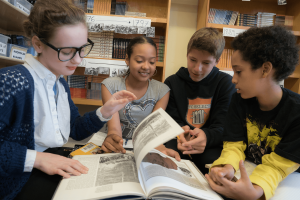
What is a book club?
Simply put, a book club is a group of readers, usually three or four, who read books roughly in sync with each other. Usually clubs read the same book, but sometimes clubs may read books by the same author, or read a series of books together that share a common genre—mystery, historical fiction, fantasy—or they may read a collection of disparate books with a common lens—thinking about interpretation, learning about shared social issues across the book.
How will you form clubs?
When forming book clubs, remember that you are helping your middle school students learn to make wise choices about study partners. You may have a hundred students, so you don’t want to be in the business of making complicated Excel spreadsheets. Instead, study your students and think about which partnerships are working well, which kids share interests, which seem to read at similar levels and rates. Then quietly coach kids into clubs. “I’m thinking that the three or four of you could make a great club . . .” always goes over well. Do this four or five times in each class, in the week before book clubs, and you’re all set. You’ll be careful to group students who read close to the same level of text complexity. Clubs provide support to readers, so it is not uncommon for teachers to use this structure to support kids moving to books that are a notch harder than those they have been reading, allowing the club to double as a guided reading group. It is also common for a club to involve a few kids who have been reading a particular level of text complexity for a while, and another reader who is new to that level.
How will book clubs get started?
Say you decide to have your kids working in fantasy/dystopia book clubs. You’ve got the books—eight titles (thirty-two copies) in this shelf and multiple copies of a few other books that you may round up to add to that shelf. Now what?
One of your first decisions will be whether you want to plunge right in, saying something to your kids like, “Readers, starting tomorrow, you will each be in a club of readers, making your way through a sequence of shared fantasy/dystopia books.” Or alternatively, do you want to ease your kids into this work? If you decide on the latter, you could read aloud a fantasy/dystopia book to kids who are sitting with others whom you imagine will eventually comprise a club. During turn-and-talks at key moments throughout the read-aloud, you can ask these groups of kids (nascent clubs) to talk together about the book. This, of course, will make conversations among members of a club much easier than they would be if the students were reading and jotting about their club books at home and then gathering just to talk, as will happen soon. If you are reading aloud just prior to the talking time, you needn’t worry over whether some kids may not have done the required reading to prepare for the club. You can also select pause points at particularly talk-worthy moments in the text, and if added help is needed, you can even launch the conversation among the whole class before saying, “Continue to talk about this in your club.”
One advantage of launching clubs this way is that as you watch kids talking together, you can then do some social engineering (“Raymond is absent. Will you join this club instead?”) that can end up making the eventual book club more successful. Another way to ease into clubs is to launch one book club at a time. If you choose that option, while most of the class reads books that have been chosen independently, you could gather four readers who you hope would be eager to constitute a new club. You could give that club support to get it off to a strong start before launching a second club.
However you choose to organize and begin clubs in your room, you will want to feel comfortable giving your kids a quick keynote about the importance of book clubs. You might nudge them to think of a time in their lives when they were part of a club or a team: a soccer club, a karate club, a chess club, a video game club. What made those clubs work well, or not so well?
Explore the new book clubs units from Lucy Calkins and TCRWP coauthors and pre-order now!


